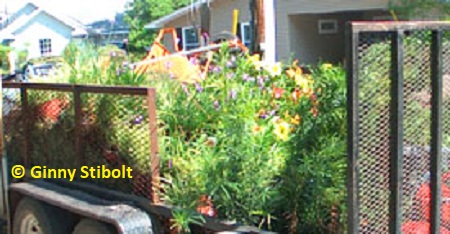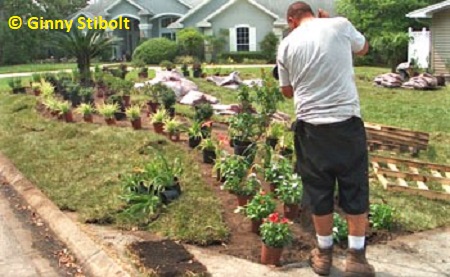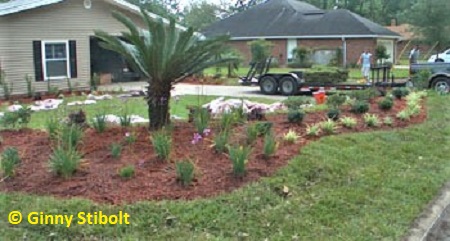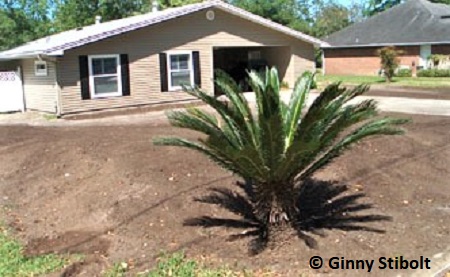Adventures of a Transplanted Gardener |
|||||||
Instant landscaping?
|
|||||||
|
|
The contouring
Before the new plants arrive, the yard was graded. Three truckloads of soil became a ridge installed along the road to provide for more interest and a little privacy. It's a clean slate for the new landscape. But drainage could be a problem in a gully-washer rainfall. I hope a French drain was installed at the front of house to channel the excess storm water to the lake behind the house.
 |
|
The plants, except for the sod, fit in one truck. |
The plants look pretty upon arrival
Because the landscape company is looking for instantaneous beauty, plants that look good at the time of installation are favored. This may leave some gaps in interest throughout the year. Ask the question about year-round displays. Another potential problem is that trees, shrubs, and perennials may be planted too close together for instant curb appeal. Ask about the eventual size and growing habits of each plant and plan for the future.
First, the landscape guys spray painted the outlines of the gardens and put the sod in place. They then moved the one existing sago (Cycas revoluta) to the top of the ridge. This location makes for a better anchor on that corner of the garden. The potted bedding plants were then set in their proposed planting sites. The owner was consulted before they were planted. I like the undulating pattern of the bed—much more interesting than a straight edge, but think about the mowing and maintenance. Mowing curving line on the sloping lawn next to the road will be a bit tricky. Don’t make it too hard to care for.
 |
|
Landscapers sink each plant in its designated spot. |
Here is the plant list:
· Liriope (Liriope
muscari `Variegata') Native to Asia - As discussed in my French
drain article, this hardy evergreen member of the lily family is
normally planted as a border.
· Society garlic (Tulbaghia
violacea) Native to Asia - Widely planted around here, this odiferous
relative of garlic is said to have been planted in South Africa to keep
out the snakes. I've noticed the smell from twenty yards away when walking
through the neighborhood. I have seen snakes in these areas, but
I haven't seen any vampires. Hmm...
· Crape myrtle ( Lagerstroemia
indica) Native to Asia - This small tree blooms all summer and has
interesting bark to look at in the winter. Hacking these trees
back to keep them hedge-like is probably not the best use in the landscape.
Yes, the common name is spelled “crape,” even though it was so named
because the flowers’ texture is similar to crepe. It's not a myrtle,
either. This is why we need scientific names.
· Assorted daylilies ( Hemerocallis
spp.) Native to Asia - These plants will do well in the full sun
and it looks like they are the ever-blooming type that will develop
flowers for more than just a few weeks typical of the standard varieties.
They'll become quite dense after a few years. All parts of the
Daylily are edible.
· Madagascar periwinkle (Catharanthus
roseus) Native to Madagascar - Often called annual Vinca and while
it is related to the true periwinkles (Vinca major & V.
minor) in cooler climates, this is widely planted for its great
colors and long blooming season.
· Dwarf yaupon holly (Ilex vomitoria
"Nana") The standard yaupon hollies are native
to Florida, but this male clone cultivar is not native anywhere. These
ubiquitous little shrubs are planted everywhere around here, but because
they are all male, there are no berries. I have several planted
along our front foundation. They are boxwood look-alikes with
much faster growth and without the boxwood's foul, cat-urine odor.
 |
|
After mulching the job is pretty much complete. |
· Indian hawthorn
(Raphiolepis indica) Native to Asia - Widely planted around here
and shaped into hedges or gumdrops. It does have berries that
the birds like.
· Yew pine (Podocarpus macrophyllus)
Native to Asia - These were planted along the front of the house and
while they do take to trimming, they can be much taller than a normal
hedge. It's neither a Pine nor a Yew, although it is a gymnosperm
like pines. Podocarpus have their own family.
· Windmill palm (Trachycarpus
fortunei) Native to Asia - a slow growing palm that can eventually
reach 40 feet. One was planted at either corner of the house -
too close for the possible future growth, in my opinion. You cannot
keep a palm short, because topping it will kill it. Once these palms
grow above the roof line, their hard fronds may damage the roof and
fruit and other droppings can make a mess of the gutters.
· St. Augustine grass (Stenotaphrum
secundatum) Gulf of Mexico region - Except for golf courses,
do they ever plant any other type of grass in northern Florida?
Notice anything? Yep, nothing, except for the grass, is native. Several native species could have been chosen. I realize that the nursery business is difficult, especially with the probable guarantees made for everything to live a year. Safe, reliable, and abundant stock is the prudent business decision, but is is best for your needs?
It is up to us, as gardeners, to provide diversity
Here's something else to consider. These plants (and a few others) are so widely planted around here that the whole region is losing its diversity. As native habitat is lost because of development or due to invasive aliens, it it up to us, as gardeners, to provide greenways on our property and diversity in our gardens.
More on possible native plant choices in the next column.
(Update: This expensive landscaping job only lasted a year before it was entirely replaced again. They hauled the extra soil away, installed a pervious driveway and a drainage system--when the wet season arrived, the instant landscape design had directed all excess water into their house! Several years later, they installed yet another instant landscape. Instant landscaping is a false promise, because a landscape is never "finished," it's an ongoing project.)
Ginny Stibolt is a life-long gardener, a botanist, a naturalist, and a garden writer. You may contact her or read more of her articles posted on her website: www.greengardeningmatters.com.
Copyright Ginny Stibolt


